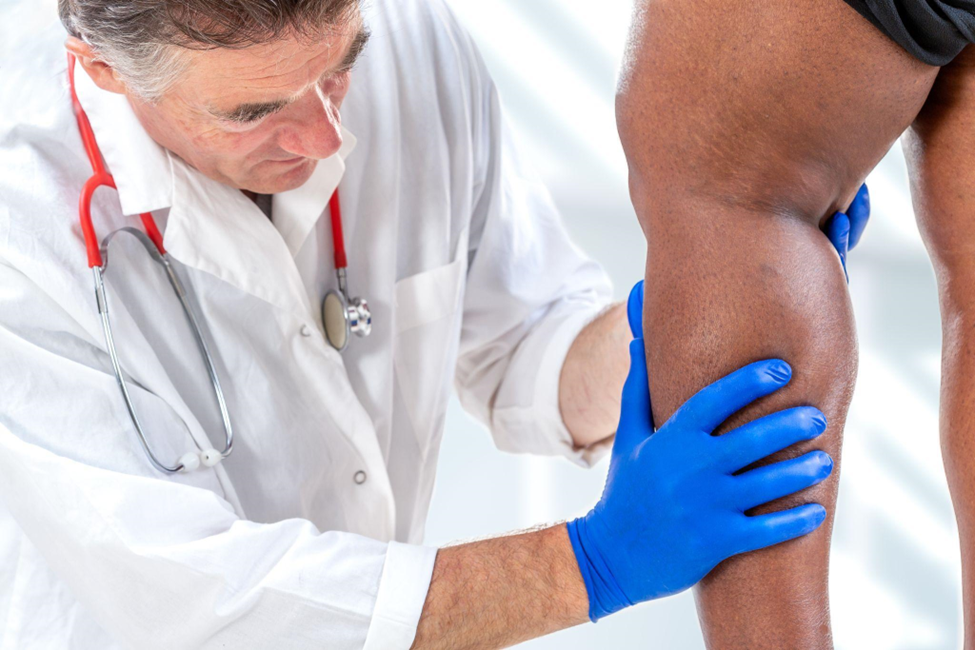
Deep Vein Thrombosis (DVT): Risks, Diagnosis, and Management
Deep vein thrombosis (DVT) is a serious and often undiagnosed condition that affects up to 900,000 people in the United States each year.1 Knowing the risk factors of DVT, as well as how this common condition is diagnosed and managed, will help prevent DVT and the complications that occur from leaving this condition untreated.
DVT Demystified: Understanding the Basics
Deep vein thrombosis is a blood clot that most commonly forms in the lower leg; however, DVT can develop in any deep veins, including the arm, thigh, or pelvis. When this occurs, a clot blocks blood flow and causes pain and swelling in the veins and limbs.
DVT can develop in two ways: A single blood clot can form, or several clots can occur simultaneously. The severity of DVT varies; clots may dissolve on their own or medical treatment may be needed to manage or eliminate blood clots. It is important to address DVT immediately as if left untreated these clots may also loosen and travel to major organs like the heart and lungs.
Recognizing the Early Signs: Symptoms of DVT
According to the American Academy of Orthopaedic Surgeons, almost half of patients with DVT will show few if any symptoms.2 While many people only experience minor symptoms, one in three people who experience DVT will suffer from additional symptoms after the disease has been treated, and many will have a higher risk of blood clots for the rest of their lives.3
Early Symptoms
Those who do experience symptoms of DVT will often describe swelling, tenderness, or painful and even red skin in the area where the blood clot is forming. When DVT is at this stage, it is recommended you schedule an appointment with your doctor to diagnose possible DVT and prevent more issues.
Other symptoms to watch out for include stiffness of the calf muscle, dilated and visible veins and the affected muscle being warm to the touch. If you have these symptoms, you should monitor them closely and call your doctor immediately if they worsen.
Established DVT
DVT symptoms, if left untreated, can advance to more painful symptoms. This includes stiffness of muscles in the affected limb, dilated and visible veins and a feeling of your limb being warm to the touch. At this stage, it is recommended that you see your doctor for both treatment of DVT and management of your more advanced symptoms.
If you are feeling pain and swelling in your limb, along with feeling out of breath, contact emergency services immediately, as this could be a sign of a pulmonary embolism.
Risk Factors and Prevention: Keeping DVT at Bay
The following risk factors for DVT are known to be direct contributors to the formation of blood clots:
- Slow blood flow due to paralysis, sitting for long periods of time or limited movement.
- Chronic medical conditions, including cancer and heart and lung disease.
- Vein injury due to surgery, muscle injury, or fractures.
- Increased estrogen due to pregnancy or recent childbirth, hormone replacement therapy or birth control pills.
- Previous or family history of blood clots or DVT.
Comorbidities such as obesity, age and catheterization of a central vein are also risk factors for developing the condition.
Prevention Strategies
There are several ways to prevent blood clots and DVT without medication. However, anticoagulant medication may be prescribed if the condition is hereditary or other chronic conditions are present.
Movement is one of the most effective ways to prevent DVT. It gets the blood flowing, promotes blood vessel growth and improves the health of arteries. Those who have been bedridden due to surgery or illness will benefit from moving as soon as they are able.
If sitting or traveling for long periods, it is important to move every one or two hours to prevent DVT. Those who are stationary for four or more hours can incorporate movement while sitting by tightening and releasing the leg muscles.
Even simple seated exercises can help prevent DVT. One seated exercise is to alternate raising your toes and heels while keeping the other on the floor. By alternating what part of your foot is raised, you will stretch your muscles and encourage blood flow even while sitting.
Other ways to prevent DVT include wearing loose-fitting clothing, staying active and keeping a healthy weight and diet. Spices like cayenne pepper, turmeric and ginger, or foods rich in vitamin E—such as walnuts, olive oil and spinach—possess anticoagulation properties.
Before changing your diet, you should talk to your doctor, as some foods should be avoided if you are already taking pharmaceutical anticoagulants.
Navigating DVT Diagnosis: Modern Techniques and What to Expect
 DVT, while serious and sometimes even painful, can be treated using both medication and lifestyle changes. One of the easiest methods for patients to manage their DVT is to wear compression stockings. Compression stockings reduce swelling in the legs by preventing blood from pooling. Typically, patients with DVT wear compression stockings every day for two or more years after diagnosis.
DVT, while serious and sometimes even painful, can be treated using both medication and lifestyle changes. One of the easiest methods for patients to manage their DVT is to wear compression stockings. Compression stockings reduce swelling in the legs by preventing blood from pooling. Typically, patients with DVT wear compression stockings every day for two or more years after diagnosis.
There are several types of anticoagulant medications available for the long-term treatment of deep vein thrombosis. These can be administered orally or intravenously, and they may need to be taken for a minimum of three months. Some blood-thinning medications will require regular blood testing as well.
Those who have not seen improvement with blood thinning medicine may need to take thrombolytic medications. These medications are administered through a catheter directly to the area where the blood clots are located. Because thrombolytics can result in serious bleeding, they are only administered to patients whose blood clots are severe.
For those not able to take medication or are at risk for future blood clots, your doctor may recommend the following treatments:
- Vena cava filter placement: People who can’t take blood-thinning medications may need to have a filter placed inside the vena cava, a large vein in the abdomen; the filter prevents clots from traveling to the lungs.
- Venous thrombolysis: This procedure is suitable for people with acute DVT; the doctor uses a small catheter to access the blood clot and then injects a medication to slowly dissolve the clot.
- EKOS® procedure: This procedure delivers clot-busting medicine directly to the clot and uses ultrasound energy to loosen the clot and allow the medication to work more effectively.
- Pulmonary embolism surgery: In rare cases, a person may need surgery to remove a blood clot from the lung.
Before Your Appointment
Before seeing a vein specialist, it’s important to make a list of your symptoms and when they began. This will help your doctor to diagnose your DVT. Be sure to list all symptoms, including those that seem unrelated to your condition.
Make sure to include all instances of any travel over an hour, surgery, trauma, illness, or hospital stays during the past three months, as well as any family or individual history of blood clots.
Gather and record the names and dosages of all medications you’re taking, along with any supplements and vitamins. Crystal Run Healthcare provides a medication list template on their website you may use, as well as tips to fill out your medications list.
Crystal Run’s Vein Center Approach: Comprehensive DVT Care and Management
Crystal Run Healthcare is dedicated to continuous improvement in the way DVT treatment and care is delivered. We provide coordinated care and treat you as a person. With locations in Middletown and Rock Hill, top-quality DVT care is always close to home.
Our patients also benefit from our extended hours and urgent care for walk-in care. We use state-of-the-art technology to diagnose and treat DVT and we hold more than a dozen quality designations, certifications and accreditations.
If you require DVT therapy or deep vein thrombosis medication or are experiencing deep vein thrombosis symptoms, the specialists at Crystal Run Healthcare offer top-quality treatment. Book an appointment with a vascular specialist online.
Sources:
https://nationaldisabilitynavigator.org/ndnrc-materials/fact-sheets/pop…
https://orthoinfo.aaos.org/en/diseases--conditions/deep-vein-thrombosis
https://www.cdc.gov/ncbddd/dvt/facts.html

 Optum Radiology at Crystal Run Healthcare
Optum Radiology at Crystal Run Healthcare Request medical records online
Request medical records online